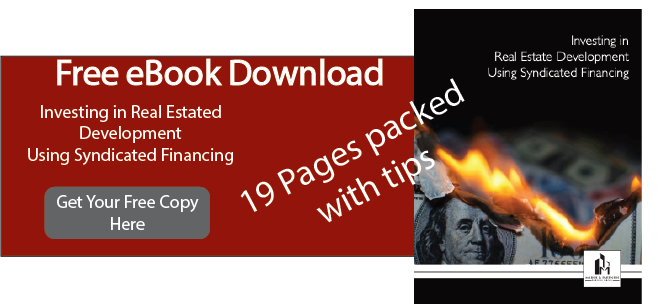How Companies Can Use Real Estate Syndication to Fuel Expansion Through Build-to-suit Development
It’s not just businesses that are benefitting from this trend, either.
Investors are getting in on the action too. Investment opportunities are being created where they didn't exist before – it has huge implications for investors that are looking for quality opportunities and businesses that are in growth mode. But let's take a step back.
I’ve heard the complaints.
“There aren’t any good deals out there right now!” Some days I’m feeling optimistic, but frankly, some days, I am saying the same thing too.
If you’re an investor chasing your next deal, or a business looking for new space, you’ve probably felt it yourself.
The real estate market is competitive right now. The lack of new home starts over the past decade have single-family rentals at a premium. And there's a shortage of quality available commercial product out there too, especially "on the market.” And there’s a lot of capital out there chasing those few properties.
But then I take a step back and think to myself, “Matt, that’s a lazy excuse.” Sure, 40% of all dollars in circulation today were printed in 2020. And yes, debt is about as inexpensive as you’ll ever find it – there’s a strong appetite for banks to chase quality risk-adjusted yield where they can find it. But great deals have never just been handed out, even during market downturns.
So, what makes this cycle so different? Maybe it’s the market’s appetite for a solid hedge against a rapidly devaluing dollar. Or perhaps it's pushback against the retail trading craze and speculative equity investments – real estate offers a tangible asset that you can physically manipulate. Whatever the case, it’s created a perfect storm that investors and businesses both must navigate.
Why today's economy has created a market ripe for real estate development
Let’s talk quickly about market value vs. replacement cost.
Real estate is subject to the same economic principles as most physical assets. As real estate assets age, deferred maintenance obligations add up, there are advancements in construction techniques and materials, and properties suffer from functional and economic obsolescence. As a result, what may have been trendy from a design and construction perspective 30 years ago probably isn't as desirable today.
The result? Existing real estate can usually be purchased at a discount relative to its replacement cost. In other words, the market value of the real estate, or the price a buyer is willing to pay for a property, is less than what it would cost to build. An adjustment for the location and relative scarcity of land is an important consideration as well.
But what happens when there is so much upward pressure on the price of real estate due to constrained supply and record liquidity in the market?
That fine line between market value and replacement cost becomes much muddier. And in some cases, new development becomes more economically feasible than finding an existing property – even in a market marred by rapidly rising construction materials prices and labor constraints.
And all this market dislocation creates inefficiency. Inefficiency in traditional capital markets to offer feasible financing solutions. Inefficiency in existing supply options to offer widespread quality return solutions for eager investors. And inefficiency in the existing market to provide adequate real estate solutions for operating businesses.
But what does this inefficiency breed? Market opportunities.
Why is build-to-suit an option for businesses?
There are a lot of businesses out there whose space doesn’t work for them. And in a perfect world, the right solution would already exist somewhere – the adequate amount of space for current and future needs, in the right location, at an affordable price. And your business would be able to write a check for it.
But in the arena of small and growing businesses, cash is always king. And today, more than ever, as a business, you're not just competing with other companies for space. You’re also competing with a sea of zealous investors looking for return opportunities – and as we discussed previously, that demand results in higher real estate prices.
But that’s why build-to-suit may be an excellent option for businesses that need a space alternative.
A build-to-suit is an arrangement where either a developer or investor custom builds a property for an end-user or operating business. The building is designed to the occupying business’s exact space and layout standards, and as a result, they’ll sign a long-term lease as a tenant.
There are a couple of reasons why a build-to-suit is a feasible option for businesses who may be in a space that doesn't quite fit their needs:
- You enjoy the benefits of custom-built real estate that meets your business’s unique needs
- Because you’re signing a lease, you aren’t adding any debt to your personal or your business’s balance sheet
- It’s a more efficient allocation of your business’s cash – you won’t have operating capital tied up in equity in your real estate
- The lease term is longer than typical lease arrangements, giving you a more predictable lease rate over a longer time horizon
You're worried about meeting payroll, paying vendors, and managing cash flow as an operating company. There's power in not having to outlay any cash for a down payment, and that has huge implications for businesses that need alternative space options.
How does real estate syndication fit in?
If you aren’t familiar with the concept of real estate syndication, we’ve written extensively on the topic, and you can find a syndication deep dive here.
But as a quick refresher, real estate syndication is the partnership of multiple investors with a mutual interest seeking to acquire a real estate asset. And it’s not strictly reserved for capital partners - real estate syndications can also include partners with who bring experience, credit, or resources to the investment team.
Syndication creates a situation where the whole is greater than the sum of its parts. The real estate industry has substantial barriers to entry – individuals may not have the capital, expertise, or time to complete a transaction themselves.
But when you marry an investment team's complementary skills and resources, you suddenly give individual investors access to a much larger pool of investment opportunities than they would have otherwise.
So instead of competing with the masses for the same overpriced and unimpressive opportunities, investors are using real estate syndication as a means of exponentially scaling their reach and influence. Not to mention reducing their risk and exposure by not being overinvested in a single real estate deal.
Perfect synergy - real estate syndication and build-to-suit development
Think about it – a tenant is only one-half of the equation in a build-to-suit arrangement. You still need an investor with deep enough pockets to bankroll the land acquisition, pre-development, development, and construction of a property.
What if you’re a manufacturing company that needs a moderately customized 50,000 square foot industrial facility with extensive shipping and distribution capabilities? The scale and potential costs of such a project are so prohibitive that only a small population of investors would have the means to finance such a project.
And what if you’re an investor that wants to participate in real estate ownership but has been stymied by the real-world barriers to entry: lack of available inventory, expertise, liquidity, etc?
Suddenly, real estate syndication opens a world of opportunities for investors in need of investment opportunities and businesses looking to expand.
And as an investor, you’d have a properly vetted, quality, and credit-worthy tenant occupying the property on a long-term lease. That’s a powerful investment combination from a cash flow and risk tolerance perspective.
How can you take advantage of this opportunity?
There are a couple of ways.
The first step is recognizing that the opportunity exists and understanding its implications; from a market value vs. replacement cost perspective and a synergy between real estate syndication and build-to-suit perspective.
As an operating company, you’ll need to determine if a build-to-suit even makes sense for your business. That begins with taking a long look at your short and long-term strategies, understanding balance sheet implications, ownership and tax consequences, and ultimately the impact on your operations. Marsh & Partners’ Commercial Real Estate Strategy Challenge can help you begin to flesh out those details.
As an investor, you'll need to find a quality real estate syndicator or deal sponsor. Many syndicators specialize in either a product type (i.e., multi-family real estate) or location (i.e., southeast U.S. markets). Sponsors also have varying experience levels, credibility, and investment parameters – risk tolerance, exit strategy, etc. It's crucial to find a syndicator you trust that shares a similar investment philosophy.
And after all that, maybe this type of deal structure doesn’t make sense for you. Still, it's essential to find a developer and real estate strategy consultant who can help coach you through decision-making.
------------
Is any of this intriguing? If so, Marsh & Partners can help connect the dots for you.
If you’re a business and your space doesn’t work for you, we should talk. Our extensive network of investors and experience as a real estate developer and an operator may be the missing link to get you into real estate that enables your business instead of hinders it.
If you’re an investor frustrated with the lack of available opportunities, we have a constant pipeline of opportunities for limited investment partners eager to participate in real estate deals.
Book some time on our calendar to see if we’re a good fit.




